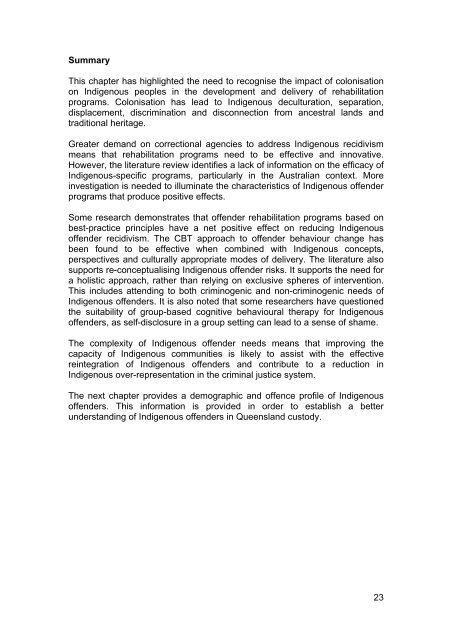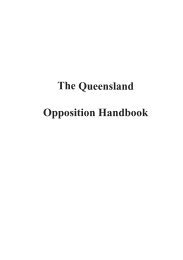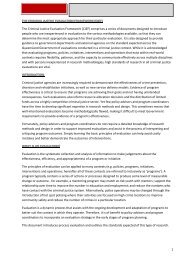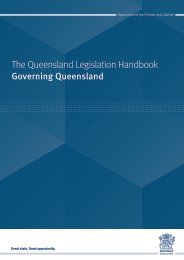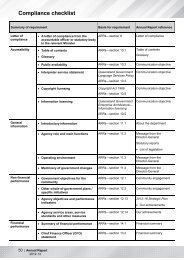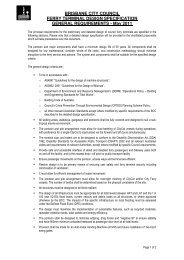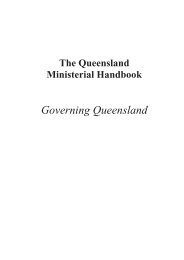Rehabilitative needs and treatment of Indigenous offenders in ...
Rehabilitative needs and treatment of Indigenous offenders in ...
Rehabilitative needs and treatment of Indigenous offenders in ...
You also want an ePaper? Increase the reach of your titles
YUMPU automatically turns print PDFs into web optimized ePapers that Google loves.
SummaryThis chapter has highlighted the need to recognise the impact <strong>of</strong> colonisationon <strong>Indigenous</strong> peoples <strong>in</strong> the development <strong>and</strong> delivery <strong>of</strong> rehabilitationprograms. Colonisation has lead to <strong>Indigenous</strong> deculturation, separation,displacement, discrim<strong>in</strong>ation <strong>and</strong> disconnection from ancestral l<strong>and</strong>s <strong>and</strong>traditional heritage.Greater dem<strong>and</strong> on correctional agencies to address <strong>Indigenous</strong> recidivismmeans that rehabilitation programs need to be effective <strong>and</strong> <strong>in</strong>novative.However, the literature review identifies a lack <strong>of</strong> <strong>in</strong>formation on the efficacy <strong>of</strong><strong>Indigenous</strong>-specific programs, particularly <strong>in</strong> the Australian context. More<strong>in</strong>vestigation is needed to illum<strong>in</strong>ate the characteristics <strong>of</strong> <strong>Indigenous</strong> <strong>of</strong>fenderprograms that produce positive effects.Some research demonstrates that <strong>of</strong>fender rehabilitation programs based onbest-practice pr<strong>in</strong>ciples have a net positive effect on reduc<strong>in</strong>g <strong>Indigenous</strong><strong>of</strong>fender recidivism. The CBT approach to <strong>of</strong>fender behaviour change hasbeen found to be effective when comb<strong>in</strong>ed with <strong>Indigenous</strong> concepts,perspectives <strong>and</strong> culturally appropriate modes <strong>of</strong> delivery. The literature alsosupports re-conceptualis<strong>in</strong>g <strong>Indigenous</strong> <strong>of</strong>fender risks. It supports the need fora holistic approach, rather than rely<strong>in</strong>g on exclusive spheres <strong>of</strong> <strong>in</strong>tervention.This <strong>in</strong>cludes attend<strong>in</strong>g to both crim<strong>in</strong>ogenic <strong>and</strong> non-crim<strong>in</strong>ogenic <strong>needs</strong> <strong>of</strong><strong>Indigenous</strong> <strong>of</strong>fenders. It is also noted that some researchers have questionedthe suitability <strong>of</strong> group-based cognitive behavioural therapy for <strong>Indigenous</strong><strong>of</strong>fenders, as self-disclosure <strong>in</strong> a group sett<strong>in</strong>g can lead to a sense <strong>of</strong> shame.The complexity <strong>of</strong> <strong>Indigenous</strong> <strong>of</strong>fender <strong>needs</strong> means that improv<strong>in</strong>g thecapacity <strong>of</strong> <strong>Indigenous</strong> communities is likely to assist with the effectivere<strong>in</strong>tegration <strong>of</strong> <strong>Indigenous</strong> <strong>of</strong>fenders <strong>and</strong> contribute to a reduction <strong>in</strong><strong>Indigenous</strong> over-representation <strong>in</strong> the crim<strong>in</strong>al justice system.The next chapter provides a demographic <strong>and</strong> <strong>of</strong>fence pr<strong>of</strong>ile <strong>of</strong> <strong>Indigenous</strong><strong>of</strong>fenders. This <strong>in</strong>formation is provided <strong>in</strong> order to establish a betterunderst<strong>and</strong><strong>in</strong>g <strong>of</strong> <strong>Indigenous</strong> <strong>of</strong>fenders <strong>in</strong> Queensl<strong>and</strong> custody.23


